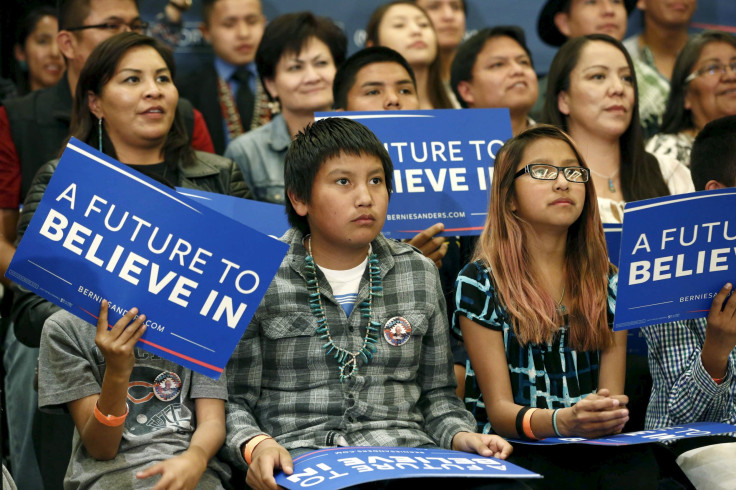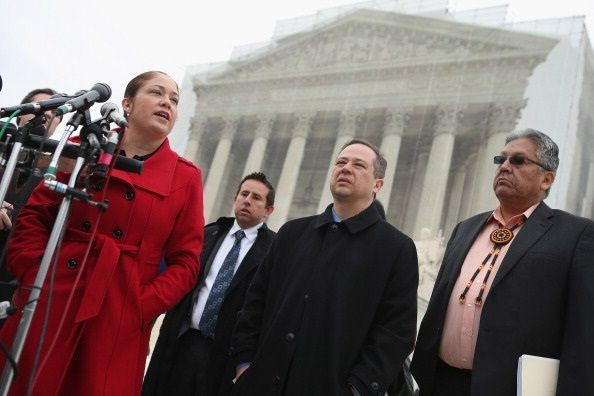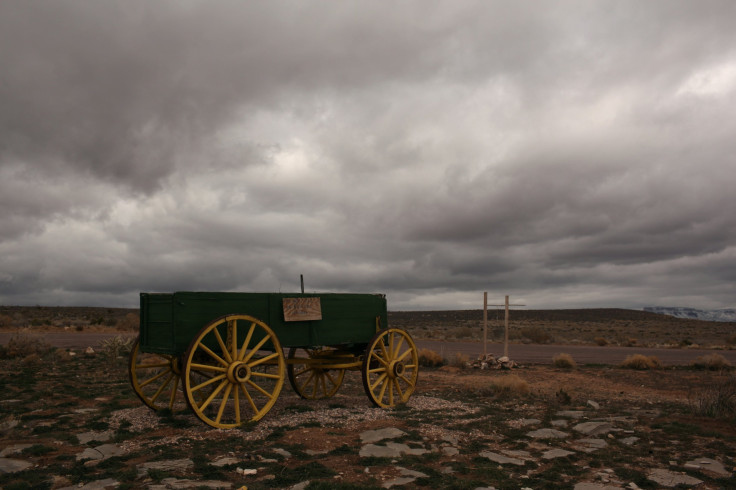Voting Rights 2016: Native Americans Struggle To Overcome Barriers Ahead Of Arizona Elections

The Navajo Nation reservation, the largest concentrated population of American Indians in the United States, is tucked into Arizona's northwest corner. Stretching across 27,000 square miles of mesas, shrubs and sand, the reservation is largely rural, often without internet access, paved roads or street signs. Employment and education rates are far below the national average, and very few people own vehicles. If residents on the reservation ever need to drive to their county seat — say, to register to vote or to cast an early-voting ballot — the journey could easily take them four hours.
Ahead of Arizona’s primary on Tuesday, Democratic candidates Bernie Sanders and Hillary Clinton have sought to reach out to Native communities and mention Native issues on the campaign trail. This year marks the first presidential election since the Supreme Court in 2013 struck down the key provision of the Voting Rights Act that required states with a history of voting discrimination to get pre-approval for new voting laws. While much of the national conversation has been focused on Southern states and laws affecting African-American and Hispanic voters, Native Americans in places like Arizona also are affected by policies that discourage them from voting, which have resulted in some of the lowest voter participation rates of any demographic group in the country.
“Arizona was one of the states covered under the Voting Rights Act, and when it got gutted, that hurt people here a lot,” said Katherine Yell, director of operations for the Democratic Party in Coconino County, Arizona, which is about 27 percent American Indian. “Arizona has what I like to call draconian voter ID laws. You have to register in advance at least a month before the election, you have to have a photo voter ID with your permanent address on it, which makes it tough for people who travel for work because there’s not a lot of work on the reservations.”

Since the 2013 Supreme Court decision, states around the country that used to be covered by the Voting Rights Act have enacted new laws they say aim to prevent voter fraud but minority voters contend suppress their voting rights. Regulations such as Arizona’s voter ID law can be tough on Native Americans because tribes don’t require official identification and only recently started providing ID cards at all.
In another example, Arizona in 2014 put more than 500 registered Navajo voters on a “suspense list”, which moved their voting status to inactive because they did not have specific street addresses. But many people who live on reservations do not have house or street numbers, and Arizona’s voter registration form actually includes a box where Navajo voters can draw the location of their home to determine their precinct.
“We are in Arizona, so there is a lot of fear that minorities will become the majority. There’s fear about that so there’s an effort to suppress people from participating whether or not there’s data to support what they’re doing,” said Patty Ferguson-Bohnee, director of Arizona State University’s Indian Legal Clinic, which works to protect American Indian voting rights.
Just this month, Arizona Gov. Doug Ducey signed legislation that makes it a felony to collect other people's ballots and bring them to polls. The law is not yet in effect, but it will be soon, and the punishment could be a year in prison and a potential fine of $150,000. Family members, those living in the same household and certain caregivers are exempted, but Ferguson-Bohnee said this law has the potential to disenfranchise many American Indians who live in remote areas of reservations and cannot make it to polling places.
Turnout among American Indians and Alaskan Natives was 47.5 percent in 2008, the lowest of any racial or ethnic demographic, according to a report by Demos, a liberal think tank in New York. That report also found that two of every five eligible American Indians were not registered to vote.
To achieve government parity you must make your voice heard at the ballot box. Every #NativeVote Counts @NancyPelosi pic.twitter.com/2b4icV3WG5
— Native Vote (@nativevote) February 24, 2016
The Democratic presidential candidates have each made it a point to speak out about injustices directed at Native communities in their speeches on the campaign trail. Clinton, who won the endorsement of the Navajo President over then-Sen. Barack Obama in 2008, has taken to including “Native rights” in her victory night speeches when she lists rights she wants to protect as president. Sanders has visited several Native American reservations this election cycle and gave a speech specifically focused on Native issues at a Navajo casino in Flagstaff, Arizona, this month.
“The Native American people have been lied to, they have been cheated, and negotiated treaties have been broken,” Sanders said, the Associated Press reported. “We owe the Native American community so much.”
Because of the way the federal government rounded up and killed many American Indians over the course of U.S. history, the remaining tribal members are clustered in a small number of mostly Western states. Before European settlers began killing American Indians, some scholars estimate there were likely around 50 million across both North and South America. These days, the U.S. has about 2.9 million American Indians or Alaska Natives, and in Arizona, there are about 300,000 Natives, or 5.3 percent of the state’s population.
Still, in close primary races like those in Missouri and Illinois last week, a few thousand votes can affect the outcome and the delegate haul of a state, and the Native vote has swayed elections. In Arizona, former Gov. Janet Napolitano has credited the Native vote with helping her win her close 2002 gubernatorial election, and in states like Oklahoma and Alaska, where American Indians or Alaska Natives make up a larger proportion of the electorate, they have helped other politicians secure close victories. Sen. Lisa Murkowski of Alaska won her historic write-in vote in 2010 thanks in part to support from the Native community there.
American Indians have a complicated history that has left them struggling in many areas beyond voting rights. Across numerous categories — alcoholism, heart disease, cancer, encounters with law enforcement, education and mortality — they fare far worse than the general population, and often worse than blacks, Hispanics and Asian-Americans, according to the Arizona Department of Health.
O.J. Semans, a member of the Ogala Sioux tribe, is co-executive director of Four Directions, an organization that advocates for Native voting rights across the country. He has worked to protect voting rights in Arizona during previous election cycles and said one of the main obstacles facing American Indian voters is the distance they must travel to cast their ballots.
Native reservations are typically located in rural areas, and counties often do not have polling locations set up on or near reservations. Until recently, Semans and other residents of the Rosebud Indian Reservation in South Dakota had to travel 60 miles to the next county to vote in elections.
“If you look at the poverty rates and transportation on reservations, you’re not going to have the transport to cast that vote,” Semans said. “If you go to Arizona, you’re going to find the same thing. They have early voting, but nothing of the conveniences that are made for non-Indians off reservations are made available for Indian reservations.”
In Arizona, more than 30 percent of American Indians live below the poverty line, according to 2010 Census data. Education rates are low, too, making jobs difficult to come by. Many people don’t own vehicles, and if they do, cars are typically shared among several families and used to transport people to jobs far away from their reservation. Filling the tank with gas for an extra trip may be a luxury they can’t afford.
Many states have early voting during the month before elections, which can help those who will be busy or out of the state on Election Day. But while counties in Arizona with large Native populations have opened Election Day precincts on reservations, the options for early voting are limited to mail-in ballots or a small group of offices with specific hours of operation.
“In Indian country, because of the social and economic conditions we have to deal with, we have emergencies going all the time. I can’t think of an Election Day in the past 30 years where we haven’t had a relative passing away prior to or on Election Day,” Semans said.
In addition to the high poverty rates and sometimes transient lifestyle, American Indians in Arizona are at 126 percent higher risk for accidental deaths than the general population, according to the Department of Health, and they have a premature death rate of 76.7 percent, the highest rate of any group measured.

Because many residents on the reservation do not have mailing addresses, they must go to the post office to get their mail. But because of their remote location, mail delivery is sporadic and there is little guarantee the correct person will get their ballot. With Arizona’s new law, they could get in trouble if friends help pick up their ballot to save time.
“A lot of people want to vote by mail, particularly younger people, so we send them ballots. But the post office can only deliver the ballots to the person listed on the address. Most nations have just one post office, and everybody would be using a box at that post office. It would be kids, grandkids, parents would use that — sometimes 10 or more people,” said LeNora Fulton, the county recorder for Apache County, Arizona, and a member of the Navajo Nation.
Even when tribal members do receive their ballots, they may have a difficult time reading them or understanding how to fill them out.
“All the elders, their first language is not English. The literacy rates are low, the education rate is low,” Fulton said. “Then they have to fill out the ballot without any explanation from a poll worker, which means errors are much more likely.”
The Voting Rights Act requires certain counties to provide assistance to American Indians and other minorities who are not fluent in English. It says that if a language is historically written, the county must provide written translations, but it does not specify every instance in which a county must provide assistance.
In Apache County and others in Arizona with large Native populations, translated ballots or recordings of instructions in Native languages are available on Election Day. But often, the ballot translations are not completed in time for early voting, Ferguson-Bohnee of the Indian Legal Clinic said, which leaves those who can’t make it to the polls and can’t read English out of luck.
Language skills are only the beginning when it comes to American Indians understanding state and federal elections. The Hopi Tribal Registrar Karen L. Shupla said her tibe’s long history of segregation and discrimination means that they are sometimes unfamiliar with the way U.S. elections work and do not have a sense of the ideology the major political parties represent.
“We are just now getting used to the idea of being a participant in the state elections,” said Shupla, who oversees Hopi tribal elections and works to inform her tribe about state and federal elections. “Our forefathers — our dads, our grandfathers — they were introduced with people on the outside, like attorneys, consultants, that’s how they learned about state and county elections. As we’ve moved on and gotten to this stage in life, we’ve become more aware of what the parties are and what the parties represent.”
This is especially problematic when it comes to elections like Tuesday’s presidential preference vote or a state election that will take place later this spring to vote on propositions. The Navajo, Hopi and other tribes in Arizona do not have political parties, so there is no need for primaries. They typically hold just one election at which they vote on all positions in tribal leadership, so the varied dates of U.S. elections can be confusing for some tribal members who do not closely follow politics.
Furthering the confusion, precincts for state and federal elections do not always match up with reservation precincts for tribal elections. The Navajo Nation reservation extends beyond Arizona into New Mexico and Utah, which means that some Arizona residents will have neighbors on the reservation who need to register and vote in a completely different U.S. state.
Fulton, the Apache County recorder, said she often sees people who will go to a polling place and try to vote because that is the location they use for tribal elections. But once they tell a poll worker where they live, they may need to drive to a different polling place miles away or even across state lines.
“It really goes back to the federal government placing Native Americans on reservations,” she said. “It’s part of a longstanding tradition of decisions that were made without Native Americans.”
This #ElectionYear I invite any candidate to Indian Country to see how tribes are building brighter futures for all Americans. #SOIN2016
— NCAI (@NCAI1944) January 14, 2016
Because Fulton is a Navajo herself, she said she understands the struggles Native American voters are facing. She has tried to provide services like translators at both early-voting and Election Day sites, but her budget is never big enough, she said. She got a grant from AmeriCorps in the last few years to help collect more data on where Navajos live and assign street names and addresses to people who had registered to vote but did not provide a full address, but the going is slow.
Other people like Semans from Four Directions are filing lawsuits when they see discriminatory laws, but that takes money, which many American Indians do not have. Ferguson-Bohnee runs a hotline on election days to take questions from Native voters and contest situations in Arizona where people report their voting rights are potentially being violated.
“If people feel like voting in an election can make a difference, they might be more willing to participate. But because Natives in many places have been neglected by the state legislature and don’t feel like their issues are reflected, they don’t vote,” she said.
Ferguson-Bohnee and the Arizona State University Indian Legal Clinic put together reports on the Arizona Native vote in 2012 and 2014, when voter turnout dropped significantly. During the midterm election, the average voter turnout at polling locations on or near a reservation was around 37 percent. For many polling locations with high Native populations, turnout was below 20 percent.
Ferguson-Bohnee said she has seen more people working to get out the vote in 2016, and seeing politicians talking about their concerns and telling them their vote matters could help persuade young Native Americans to vote.
“When people see you have an interest in them, it makes them feel like they can participate,” Ferguson-Bohnee said. “We always have these roadblocks and we have to figure out how to overcome them. We have to figure out how to empower people to deal with these challenges.”
© Copyright IBTimes 2024. All rights reserved.






















